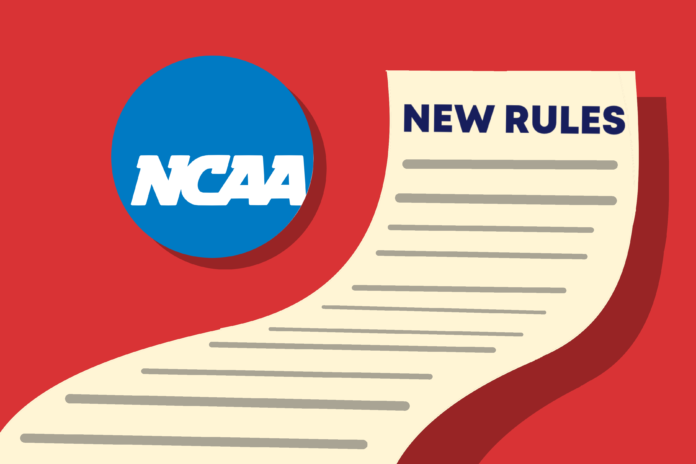Board releases 31-page plan outlining recommendations for athletes, schools
In October of 2019, the National Collegiate Athletic Association (NCAA) Board of Governors announced its decision to begin allowing student-athletes to be compensated for their own name, image or likeness (NIL). In the weeks and months that followed the announcement, many questions remained, including how to ensure these new rules would not create an unfair imbalance in collegiate athletics.
On April 17, the NCAA finally provided some additional clarity on how it planned to move forward with “modernizing” NIL rules. In its 31-page “final report and recommendations” document, the NCAA Board of Governors Federal and State Legislation Working Group outlined the basic guidelines it planned to use in crafting its new NIL rules.
Student-athletes will now be able to take advantage of their own success and marketability. They will have the opportunity to be paid for their social media influence, appearing in commercials, giving athletic lessons, holding autograph signings and more. Athletes that enter college with a national following, or develop one during college, will be able to capitalize off that by seeking out paid opportunities — but many believe that the majority of athletes will receive the bulk of their endorsements locally.
Schools in any pre-existing NIL negotiations or activities will be excluded from this. While student-athletes will continue to be a part of their respective school’s program, they are not permitted to be paid by the universities themselves or be classified as employees of said schools. Colleges, universities and their athletics departments are to play no role in the student’s activities regarding seeking compensation for their NIL.
Another major recommendation set out by the NCAA states that a student-athlete is not allowed to show any signs of affiliation, like a school or conference logo, when conducting NIL activities. This allows the NCAA and its member organizations to further distance themselves from such dealings.
Opponents of new NIL guidelines have been concerned about the nature of possible student-athlete deals, as some say they could be used to create improper incentives for certain players or programs to sway a recruit away from another school. But the NCAA emphasized that these potential deals will be completely separated from athletics.
“Any compensation received by student-athletes for NIL activities represents a genuine payment for use of their NIL, and is not simply a disguised form of pay for athletics participation,” the report reads. “Schools or boosters are not using NIL opportunities as a recruiting inducement.”
These recommendations may seem cut and dry on paper, but in reality, the NCAA will likely have a difficult time keeping track of recruits and ensuring that NIL deals do not have a direct impact on a recruit’s decision. Especially when it comes to well-known, power five programs, there are obviously more opportunities for student-athletes to capitalize on their NIL at these schools compared to others.
“It is representative of progress in economic freedoms and rights for student-athletes, which I think is very positive,” said UC Davis Director of Athletics Kevin Blue in an email. “There are a number of granular details that will still be worked out.”
Although these rules seem to favor schools with bigger and more lucrative athletic programs — football in particular — that doesn’t mean that similar opportunities for student-athletes are nonexistent at schools where athletics are on a comparatively smaller scale.
“The visibility for student-athletes at some of the FBS programs is certainly higher, therefore the earning potential […] is higher,” Blue said. “But I would not underestimate the earning opportunities that will present themselves locally. Our intention is to educate our student-athletes as to how they can best optimize their earning potential.”
How some schools will go about adapting to these new rules — which will go into effect at the beginning of the 2021–2022 academic year — remains to be seen, but UC Davis Athletics seems to be committed to helping its student-athletes. Blue, at least, sees this as a possible learning experience for student-athletes, rather than a hindrance to their academic performance.
“There are people who believe increased commercial rights […] will have an impact on academics, I just don’t believe that at all,” Blue said. “In fact, these commercial experiences will help student-athletes become more sophisticated about how the real and business worlds work.”
A major takeaway from the NCAA’s report is the organization’s continued attempts to separate itself from student-athletes and underscore the fact that the students aren’t employees of the NCAA or its member universities. While the NCAA is loosening its financial hold over these athletes, it still emphasizes that all new NIL rules must be made in congruence with its “core values, mission and principles.”
The plan on paper seems reasonable, as some student-athletes will finally be able to freely profit off of their own hard work and talent. How the NCAA will go about enforcing these rules, however, is still unclear, as many more details are set to be released in the near future. Nonetheless, endorsement deals, social media influencing opportunities and much more will be at the disposal of college athletes across the country, as they will soon begin the new era of college athletics.
Written by: Omar Navarro — sports@theaggie.org





